
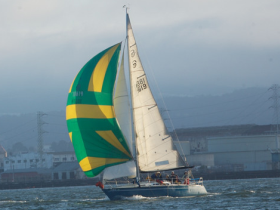 Home
Home
»
Carpool
»
Contact Info
»
Debrief
»
Fleet Info
»
Links
»
Logistics
»
Marks & Courses
»
Photos & Videos
»
Procedures
»
Results
»
Rules
»
Sitemap
»
|
Rules
The Friday Night Series is governed by the Racing Rules of Sailing and South Beach Yacht Club's (SBYC's) Sailing Instructions.
Racing Rules of Sailing
Background
The Racing Rules of Sailing (RRS) govern the sport of sailboat racing. The International Sailing Federation (ISAF) publishes the Racing Rules of Sailing every four years. The four year cycle is keyed to the Summer Olympics, and is intended to allow sailors maximum time and opportunity to become familiar with the rules that will apply at the next Olympics.
Individual governing bodies of the International Sailing Federation can make limited changes and additions to the Rules in the form of prescriptions. The intent is to make it easy for sailors to determine the rules that apply when sailing in another country: They only need to read the prescriptions in order to be aware of what changes and additions to the rules apply, in addition to changes that might be contained in the Notice of Race (NOR) or Sailing Instructions (SI) for a particular race. The national governing body for sailing in the United States is US SAILING.
Full Rules
See the links below for the full text of the Racing Rules of Sailing and the US SAILING prescriptions:
Summary of Rules
Executive summary:
- Port-starboard rule: a boat on port tack has to keep clear of a boat on starboard tack.
- Overtaking boat rule: if boats are on the same tack without an overlap, the overtaking boat must
keep clear.
- Windward-leeward rule: if boats are on the same tack with an overlap, the windward boat must keep clear of the leeward boat.
- Quick way to tell if your boat is windward or leeward: If your boom is on the same side as the other boat, you are the windward boat.
- If the overlap was established by "breaking the glass" (the leeward boat crossed the overlap line with its bow within 2 boat lengths of the windward boat), the leeward boat can only head up to its proper course.
- If the overlap was established any other way, the leeward boat can head up all the way to head-to-wind.
- Start line:
- There is no rule against "barging" – barging is just an application of the windward-leeward rule.
- There is no proper course – leeward boats can always sail head-to-wind.
- Weather mark:
- For boats on different tacks, the port-starboard rule applies (there is no zone).
- For boats on the same tack, rights are fixed when the lead boat crosses a 3-boat-length zone around the mark (imagine that a snapshot is taken when the lead boat crosses into the circle):
- If there is no overlap when the lead boat enters the zone, the lead boat is clear ahead and can take the mark however is best for that boat.
- If there is an overlap when the lead boat enters the zone, the inside boat has mark-room (it must be given enough room to go around the mark in a seamanlike manner).
- Leeward mark:
- Rights are fixed when the lead boat crosses a 3-boat-length zone around the mark (imagine that a snapshot is taken when the lead boat crosses into the circle):
- If there is no overlap when the lead boat enters the zone, the lead boat is clear ahead and can take the mark however is best for that boat.
- If there is an overlap when the lead boat enters the zone, the inside boat has mark-room.
- For leeward marks, boats are deemed overlapped regardless of what tack they are on. That means that a boat on port tack can have right-of-way over a boat on starboard tack, if the boat on port tack is the inside boat and there is an overlap when the boats enter the zone. (For weather marks, a boat on starboard tack always has right-of-way over a boat on port tack – boats are deemed overlapped only if they are on the same tack.)
- Reaching marks are treated like leeward marks for purposes of the rules.
Longer, illustrated summary:
- A starboard tack boat has right-of-way (ROW) over a port tack boat:
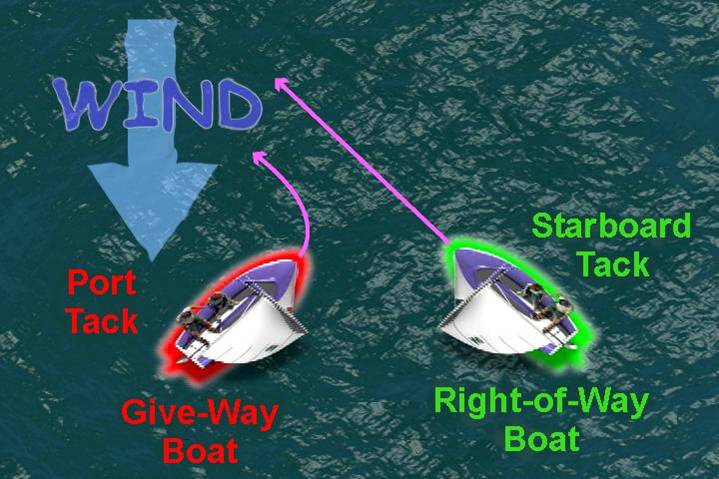
- If two boats are on the same tack and there is no overlap, the boat that is clear ahead has ROW (the overtaking boat must keep clear):
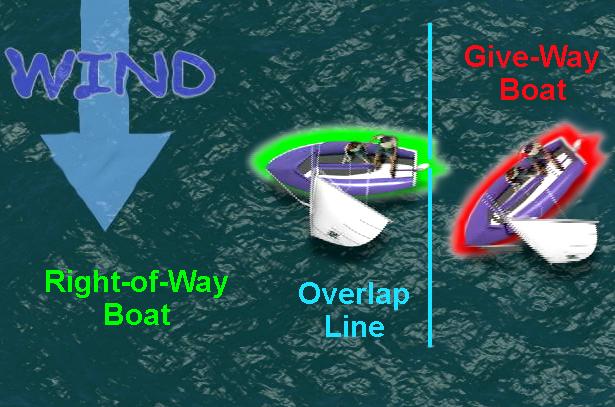
- Two boats are overlapped if the aft boat crosses an imaginary line that runs through the aft-most point of the forward boat (the imaginary line is perpendicular to the forward boat).
- When boats are not overlapped, the forward boat is called clear ahead, and the aft boat is called clear astern.
- If two boats are on the same tack and there is an overlap, the leeward boat has ROW over the windward boat:
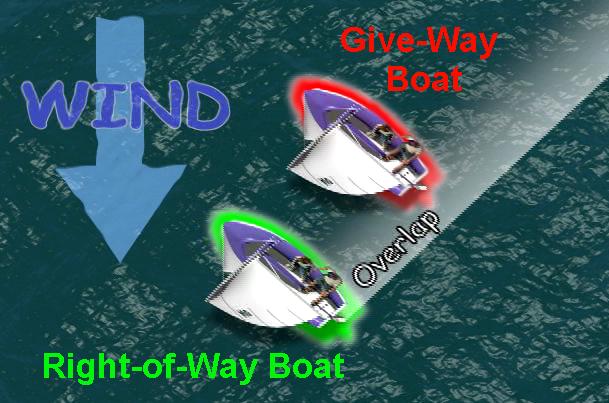
- Example: Two boats are on the same tack sailing to weather, and there is no overlap between them. In this situation, the boat that is clear ahead has ROW. If the boat that is clear astern catches up and establishes an overlap with the boat ahead, that boat then becomes the leeward boat and acquires ROW.
- Before the start line: the leeward boat can force the windward boat to head up, all the way until the leeward boat is sailing head-to-wind.
- After the start line: how far up the leeward boat can force the windward boat depends on how the overlap was established:
- If the leeward boat established an overlap by "breaking the glass" (its bow crossed the overlap line within 2 boat lengths of the windward boat), the leeward boat cannot sail further up than its proper course.
- If the leeward boat established an overlap any other way, it can sail up all the way to head-to-wind.
- A proper course is basically the expected heading a boat would sail on if the other boat was not there.
- Sailing around marks & obstructions:
- Rights are determined based on whether or not there is an overlap at the time that the lead boat enters a 3-boat-length zone around the mark.
- If there is no overlap when the lead boat enters the zone: the boat that is clear ahead has ROW and can go around the mark however is best for that boat.
- If there is an overlap when the lead boat enters the zone: the inside boat has ROW (called mark-room). Outside boats must give the inside boat room to go around the mark in a seamanlike manner.
- Rights are fixed when the lead boat enters the three-length zone, and do not change after that. The boat that has ROW at the time the lead boat crosses the three-length zone keeps ROW until it rounds the mark.
- Example: If a boat is clear astern when it enters the three-length zone (ie, there is no overlap), it must keep clear of the boat ahead, even if it overlaps the boat ahead and becomes the inside boat within the zone.
- Overlaps are established separately for every pair of boats, at the time that the boat in the pair that is closer to the mark enters the three-length zone (ie, when it is within 3 hull lengths of the mark).
- Overlaps apply transitively: If A overlaps B and B overlaps C, A overlaps C.
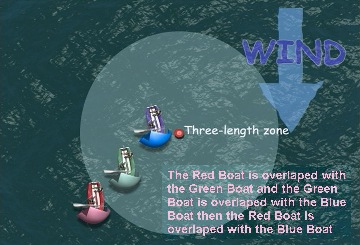
- If it's not clear whether or not there is an overlap, boats must use the last clear status quo.
- Example: If two boats were clearly overlapped half a mile back, and then it became unclear whether the boats were overlapped, and it remained unclear when the lead boat entered the zone, the boats are deemed to have had an overlap at the zone, because that was the last clear status quo.
- The inside/outside rule applies to leeward marks and reaching marks. The rule does not apply to boats on opposite tacks heading to a weather mark.
- When heading to a weather mark, a boat on starboard tack has ROW over a boat on port tack, even if the boat on port tack is inside and overlaps.
- Another way of saying this is that going upwind, boats are considered overlapped only if they are on the same tack. If boats are on different tacks, the boat on starboard tack always has ROW. If boats are on the same tack and overlapped, the inside boat has ROW.
- In contrast, when going downwind, boats are considered overlapped regardless of tack. Thus, a boat on port tack can have ROW over a boat on starboard tack, if the two boats are overlapped and the boat on port tack is the inside boat.
- Keeping clear:
- A give way boat (burdened boat) must give a boat with ROW the opportunity to do whatever it wants, whenever it wants.
- In particular, the ROW boat must be able to turn in either direction at any time.
- A burdened boat can foul a ROW boat just by being too close to the ROW boat.
- A boat must avoid collisions even if it has the ROW.
- When in doubt, stay out: If you're not sure of the rules, it's better not to mix it up.
- When a boat with ROW turns, it must give other boats a chance to keep clear.
- If your boat is the leeward boat, it's ok to yell "up! up! going up!" to a windward boat.
- If your boat is on starboard tack, it's ok to yell "starboard" to a boat on port tack.
- Penalties:
- If a boat hits a mark, it must execute one 360° turn.
- For other violations, the boat must execute two 360° turns.
- Penalties must be taken as soon as possible.
- If a boat starts prematurely, it must go back behind the start line and start again.
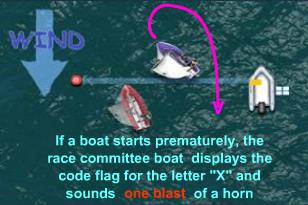
See the links below for additional summaries and illustrations of the Rules:
Sailing Instructions
Here are SBYC's Sailing Instructions for the 2016 Friday Night Series:
Here are a few highlights:
- Communications:
- Official notices and changes to the Sailing Instructions will be posted on the
electronic bulleting board
by 2:00pm on the day they take effect.
- Radio communication with the Race Committee is on VHF 78.
- Fleets:
- There are 7 fleets (classes): D, E, F, G, H, J, K.
- Northern Light is in
Class D (Delta)
class E (Echo)
class F (Foxtrot)
class G (Golf)
class H (Hotel)
class J (Juliet)
class K (Kilo)
.
- Courses:
- Courses 1-7 are all port roundings.
- For courses 8-17, all temporary marks (with the exception of the gate) will be either port roundings or starboard roundings:
- If a red flag is displayed at the start, the temporary marks will be rounded to port.
- If a green flag is displayed at the start, the temporary marks will be rounded to starboard.
- Starts:
- Boats are requested to sail by the Committee Boat prior to the first warning to check in.
- For Class D, the warning signal is at 6:30pm, and the start signal is at 6:35pm.
- For Class E, the warning signal is at 6:35pm, and the start signal is at 6:40pm.
- For Class F, the warning signal is at 6:35pm, and the start signal is at 6:40pm. Note that the classes do not start in alphabetical order – Class E starts last.
- For Class G, the warning signal is at 6:45pm, and the start signal is at 6:50pm.
- The Race Committee may combine fleets into a single start while still scoring separately by designated fleet.
- Boats must start within 4 minutes of their start signal.
- The start line is between the staff with the orange flag on the Race Committee boat and the buoy SC1
(or a temporary orange buoy called T1).
- Boats shall not cross the start line except when preparing to start or starting.
- Recalls:
- The Race Committee may hail a boat that is over the start line early.
The failure of a hail or the failure of a boat hearing the hail shall not be grounds for redress.
- Time limits:
- Boats that finish after sunset are requested to shine a light on their sail number when approaching and crossing the finish line.
- Boats that finish after 9:00pm must take their own time and report it to the Race Committee by 9:45pm.
- Boats must finish by 9:30pm (boats that finish after that will be scored "Did Not Finish").
- Protests:
- Protest forms must be delivered to the Race Committee by 10:00pm.
- Scoring and awards:
- Races will be scored using
time-on-time rather than
time-on-distance.
- Trophies will be awarded for the entire Friday Night Series.
- Throwouts:
- First half and second half: there will be 1 discard if 5 races are completed in the series.
- Overall series: there will be 2 discards if 12 races are completed in the series.
Additional Information from SBYC

For additional information about the Friday Night Series, see:
- 2016 Friday Night Series – First Half
- 2016 Friday Night Series – Second Half
|

 Home
Carpool
Contact Info
Debrief
Fleet Info
Links
Logistics
Marks & Courses
Photos & Videos
Procedures
Results
Rules
Sitemap
Home
Carpool
Contact Info
Debrief
Fleet Info
Links
Logistics
Marks & Courses
Photos & Videos
Procedures
Results
Rules
Sitemap
